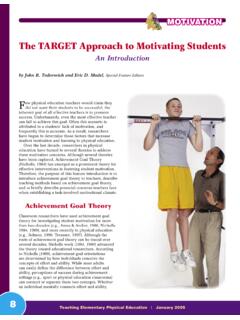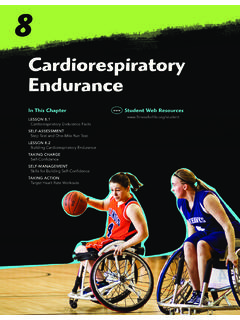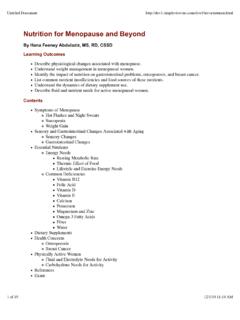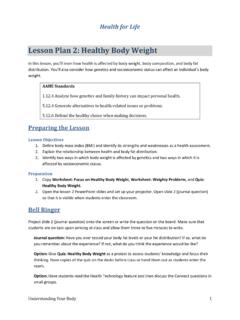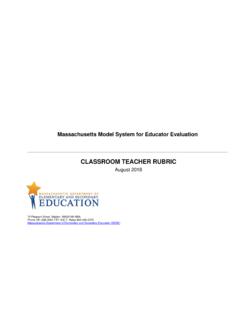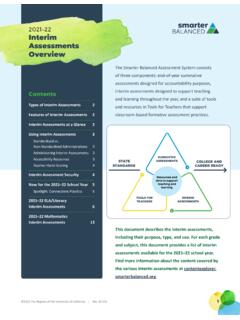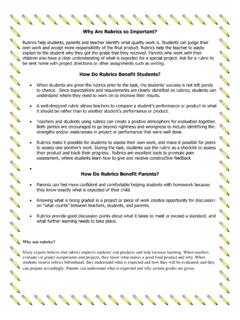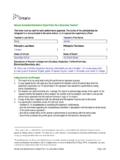Transcription of Using Instructional Rubrics in Physical Education
1 36 Teaching Elementary Physical Education | May 2006 37 Teaching Elementary Physical Education | May 2006 Using Rubrics to assess learning outcomes has been popular in Education for over a decade. Rubrics have been identified as an important tool for assess -ing student performance, teacher effectiveness, and quality of the programs. Teachers in different subject disciplines have successfully used Rubrics to achieve educational goals. For example, English teachers often use Rubrics to evaluate students writing and reading abilities ( , Goodrich, 1996; Schirme & Bailey, 2000).Recently, Physical educators have become interested in Using Rubrics in their teaching.
2 Rubrics have been used for student evaluation and grading in Physical Education (Mohnsen, 1998) and Physical Education program assessment (Rink et al., 2002). In fact, there are endless opportunities for Physical educators to use Instructional rubric is defined as a one-or two-page document that describes varying levels of qual-ity, from excellent to poor, for a specific assignment (Andrade, 2000, ). There are different formats of Instructional Rubrics . For instance, a checklist consists of critical elements of a performance or assignment. A rating scale is a tool used to compare a performance or task with predetermined criteria and give it a numeri-cal rating ( , 1, 2, 3, or 4).
3 A typical Instructional rubric includes a fixed scale that lists characteristics of a performance or task for each point on the Instructional Rubrics promotes student learn-ing and improves the quality of teaching. Developing and Using Instructional Rubrics gives Physical educa-tors access to valuable information about student performance that cannot be obtained from traditional assessment approaches; and the performance feedback provided to children is more accurate and useful. As a communication tool, Rubrics help children understand what they are expected to achieve. Sharing a rubric along with the task helps them stay focused on relevant aspects of the task.
4 Furthermore, Rubrics allow the teacher to accurately assess student performance that might otherwise be difficult to measure or indicates that Physical educators are capable of Using Rubrics in Physical activity and sports settings with minimal training (Williams & Rink, 2003). Once Physical educators know how to develop instruc-tional Rubrics , they will find them to be quick, conve-nient, and effective Instructional Rubrics in Physical Educationby Jianyu Wang and Richard M. RairighHow to Develop Instructional RubricsInstructional Rubrics can be developed based on learn-ing objectives, student skill levels, and assignments in all three domains (psychomotor, cognitive, and affec-tive).
5 They can also be individualized and task , there are several steps to developing Instructional Rubrics . Prior to constructing a rubric , it is important to determine the content that will be taught, with content objectives based on state and national standards. The first step in developing a rubric is to identify essential and critical elements of the performance or task. Then, describe performance indicators for each of those elements. This step greatly affects the quality of the rubric . If elements critical to the performance or task cannot be identified, perfor-mance assessment will not be successful and accurate. Physical educators must develop a deep understanding of performance characteristics and know not just what a good performance looks like, but what should be assessed.
6 They should also be aware of their students developmental levels and learning abilities in order to have reasonable expectations for what students can accomplish and the highest levels they may second step is to articulate criteria and levels of quality. A clear description clarifies the quality of the performance at different levels. The criteria for each level must be lucid and concise. The performance levels may be listed from low to high or high to low, but there will typically be no more than five levels. If developing a checklist, identify the critical elements; then, define performance levels for each one to elimi-nate subjectivity in observation and increase the third step, apply the rubric while teaching.
7 Trying the rubric out in a class helps the teacher see whether it will work well. If it becomes evident that the rubric cannot accurately measure student perfor-mance, the teacher must identify the flaws and make appropriate revisions become the fourth step. Think about questions such as these: Are the performance indica-tors appropriate to the task? Are the criteria for the levels clearly described? Are the criteria proper to the 38 Teaching Elementary Physical Education | May 2006 39 Teaching Elementary Physical Education | May 2006 developmental levels and learning ability of the stu-dents? Sometimes, several revisions are needed before the rubric works specific elements of the rubric is essential to helping students become successful.
8 Prepare them ahead of time for what is expected. This increases the opportunity to understand, practice effectively, and set goals for mastering the DomainDevelopment of motor skills is a primary objective in Physical Education , specifically Standard 1 (NASPE, 2004; Rink, 2002). Research indicates that essential motor skills and confidence in Physical abilities con-siderably influence the enjoyment of Physical activity among young people (CDC, 2000). In elementary physi-cal Education , teachers must spend a great deal of time to help children develop fundamental motor skills. Mastery of the fundamental motor skills builds a strong foundation for children to learn more complex and spe-cialized sport skills at the elementary level should emphasize qualitative changes within fundamental motor skills and assess those changes over time.
9 The qualitative changes reveal the incremental process of mastering motor skills. Physical Education teachers often use two different approaches to assess children s overhand throwing. These approaches reveal different aspects of motor skill development: process and children throw a softball for distance is a product measure. A weakness related to this approach is that the distance of the throw may not totally be explained by mastery of the skill itself. Other factors, like body height and muscular strength, can also affect the alternative is to use a rubric to assess qualita-tive characteristics of the overhand throw. This is a process measure. The rubric provides more valuable information regarding mastery of the skill and the movement s quality.
10 From the perspective of helping children develop fundamental motor skills, examina-tion of the qualitative changes is more important and Rubrics that measure qualitative char-acteristics can also be used to promote the process of developing motor skills over time. A well-constructed rubric helps the teacher identify where children are, in terms of mastery, and what they need to work on next. So, the rubric can be used as a means of instruction and to guide students goal suggestions to think about when develop-ing and implementing Instructional Rubrics for fun-damental motor skills include the following: Criteria within a rubric should reflect critical elements and focus on main phases of a motor skill.
